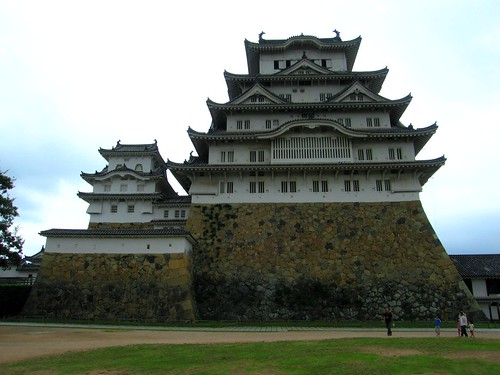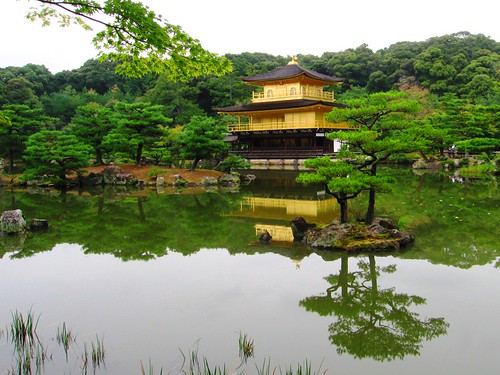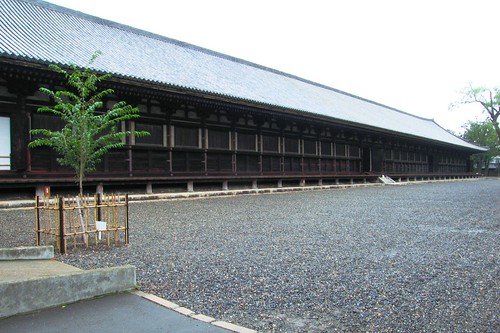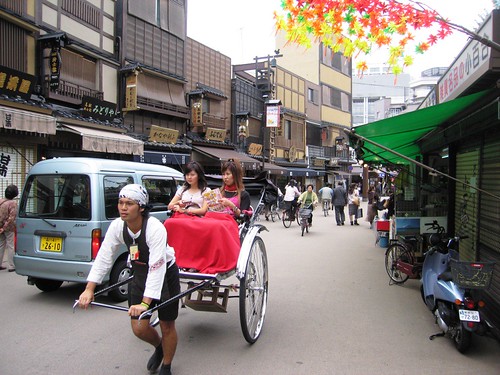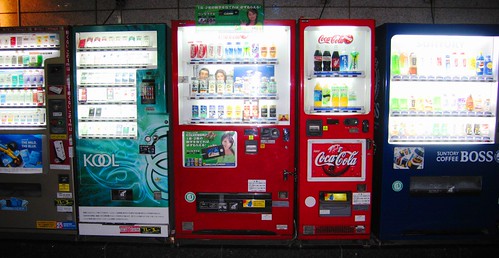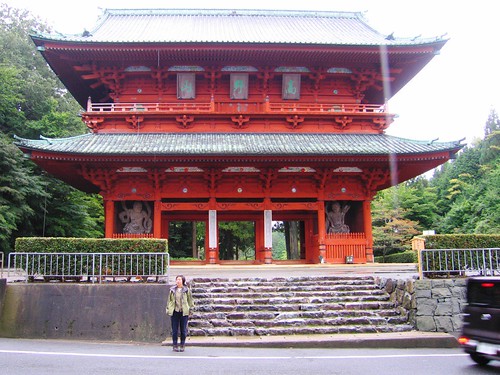Plan for the day: Nara Temples and Moon Viewing
Up at 7AM and out around 7:30 AM. Bought coffee and pasties at same Boulangerie as yesterday and caught the 8:09 train to Nara. At Nara Station, made a quick stop at Tourist Info and then jumped on the 9:29 Yamatoji Line train to Ikaruga Station. The station is under construction, but we made it out in the right direction and walked the 15 minutes to Horyuji Temple complex (1000 Yen each). OK. A small museum, and the oldest wooden buildings in the world. Yes? It is a UNESCO World Heritage Site.
Horyuji Temple

Looked to us that many of the Oldest Wooden Buildings in the world have been reconstructed or given face lifts. Haven’t; these folks ever seen the Antiques Road Show. Refinishing kills the value. ;-)
But seriously, the temple complex dates to 552AD, just after Buddhism was brought to Japan. The pagoda had interesting art. Ceramic, realistic, figures of people watching a reclining Buddha enter Nirvana. You don’t usually see “realistic” human figures in Buddhist temples.
Toured the museum and the 8-sided temple. Walked back to the station, past soy bean fields, and some “cool” boxy cars.
Back to Nara about noon. Walked uptown and had a delicious meal at Mellow Café, recommended by Rough Guide. We each had the curry lunch special: A taro curry and all the rice and bread you can eat with oolong iced tea. All for 1050 each. A great break. Yum!
The Mellow Café was modern with hip wait staff, wood furnishings and would have “fit in” anywhere in Europe or the States. They were almost full with a “business lunch” crowd.
Then back to TI at the other train station were they recommended against biking to the temples – too many steps and stairs. First some shopping. Bought a cross-stitch book for 1650. Then to the temples.
First, Kofukuji, with its 5-story Pagoda which can be seen from nearby lake. We did not pay admission, just walked around. We noticed activities at the lake that appeared to be preparations for Mid Autumn festivities (or here they call it the fall Full Moon Viewing Fair).
Then on to Todaiji Temple (East Big Temple) and Daibutsu (Big Buddha). Admission is 500 each, about $4.50 US. Todaiji Temple is the world’s largest wooden structure with a very large bronze Buddha statue inside. Way cool. The sun began to come out.
Todaiji Temple.

The Big Buddha

There were lots tour groups. Foreigners, local school kids, and locals. The kids enjoyed squeezing through a hole in one of the temples immense pillars.
Then up the hill to the nearby North Temple which had a pretty good view back to Nara.
View back to Nara from North Temple.

The temples are located around Nara Park, which is home to several museums, and about 1000 tame deer who can be a nuisance to tourists and children who have food. There are vendors who sell “deer food”. One old woman was shouting “Bambi cookies” to an arriving tour group.
The sum was out and we walked the 1.2 km to the Kasuga-Taisha Shrine which features lots of lanterns inside and out. We did not pay to see the “treasures”. Then a straight 1.9 km walk back to the station.
The Full Moon Viewing Fair was in full swing when we walked by about 4:30. Vendors: food, games, goldfish, French fries, crepes, green rice cakes filled with red bean paste – yum, cakes, skewers, etc. And at least 100 photographers had set up tripods on one side of the lake to save a spot for best view of the lake, pagoda and rising full moon. I should have found a spot for my 3 inch mini-pod but did think of it until later. ;-)

We did some shopping – bought 2 aprons and a cloth screen. Then we saw a procession coming down the shopping arcade. Men and women, young and old, with funny black hats like priests wear in Japanese movies – somewhat like coneheads - several carts. The procession processed slowly and eventually circled the pond.
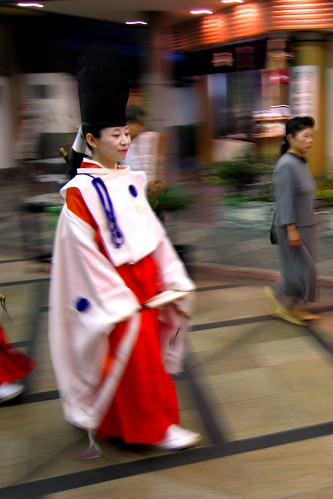
We bought more snacks and watched some sort of Shinto Ceremony with ritual dancing.
Then to a café for cake and sandwich. By then the main procession had boarded 2 boats and made a turn around the lake.
We left the Fair and scooted back to the station and caught the 7:38 back to Kyoto. Got another 9000 yen out of the ATM at central PO. Back to Yuhara and paid bill of 25200 and we are left with 2000 for tomorrow to by coffee and snacks.
Took bath, packed as tomorrow we must get up at 6:10 and be door at 6:30 in order to catch the 7:13 back to Fukuoka.
SLHOTD: Full Moon Viewing Fair.
To see all the photos from Oct 06 click here.
Oct 07, 2006
Up and out as planned Caught the train. In haste, transferred to the wrong bullet train; however, with the conductor’s help, we got off at the next station and got on the right train Caught the plane and arrived home in Shanghai with no problems.
Observations on Japan
1) Why are we living in the “wild west” Shanghai when we could be living in “civilized” Tokyo or some other Japanese city?
2) Japan is not that crowded, with easy access to nature and wide sidewalks; and generally it's easy to move along in the pedestrian areas.
3) The cars are way cool. The boxy look is in. Did not see many Honda Accord sedans. Not many large SUVs. The Nissan Cube rules.
4) Getting around on public transport is easy, especially if one is used to using Public Transportion in a large city. English signage and announcements abound. “We are traveling @285 km/hr” announces the message board at the front-end of the train car. It’s a bit bumpy at that speed.
5) I was surprised by how many Japanese speak English well enough to give directions, take an order,conduct basic shopping transactions, fix our train mistake, and take a train reservation. SL says it’s because the places we went have lots of tourists. But I wonder how many foreigners wander in to the 38 Noodle Mansion in Kyoto or the other small restaurants we visited?
6) Vending machines: while there are a lot, they mainly dispense drinks and smokes, not everything as commonly said.
7) Japanese are very polite and like their space - nnlike the Shanghaiese. SL believes one cannot live cheaply in Japan as housing is expensive and so is food; compared to Shanghai where housing is a bit steep but food is cheap.
